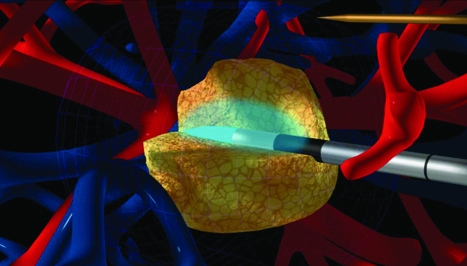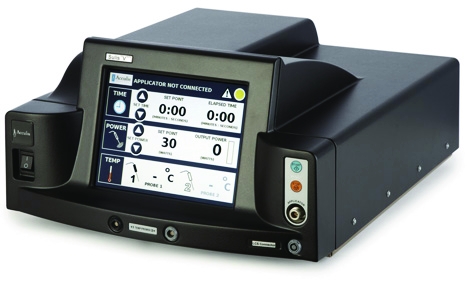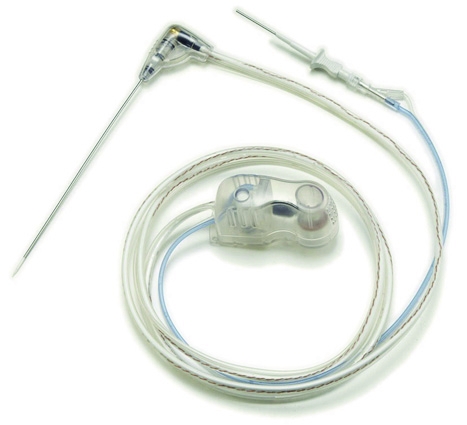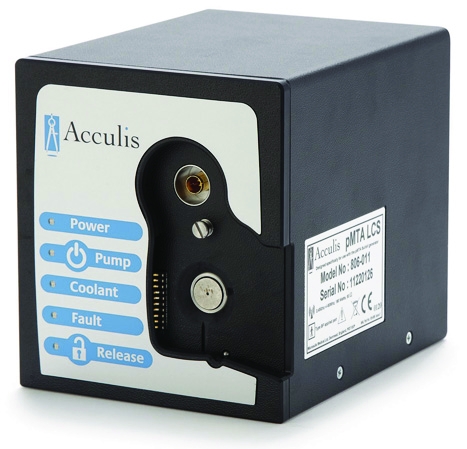Last year was officially designated the year of radiotherapy, marking 100 years since Marie Curie won a second Nobel Prize for her work on radium.
Radiotherapy is still an important part of the armoury in the fight against cancer, but in the past decade or so other parts of the electromagnetic spectrum have been exploited for the purpose of treating tumours, offering certain benefits. For a start, one of the central paradoxes and problems of radiotherapy is that, while the radiation does a good job of killing malignant cells by damaging their DNA, it can also cause new, secondary tumours through the build-up of genetic errors in healthy cells.

By contrast, newer techniques use lower frequencies to essentially heat cancer cells locally to a temperature that is cytotoxic - a phenomenon termed thermal ablation.
‘All medical devices ultimately are driven by a medical need, and understanding the medical need really creates a starting point for the science,’ said Stuart McIntyre, chief executive officer at Microsulis Medical, a specialist in thermal ablation.
‘In the case of tumour ablation, the medical need is to somehow render the tumour cells dead and to prevent them continuing to replicate and the disease from progressing. The important thing is you look within the electromagnetic spectrum at the clinical effects at different frequencies - ultimately what you get are slightly different ways of heating and therefore different depth of penetration and zones of ablation you are able to generate.’

Lasers have been used for several decades in the treatment of superficial pre-cancerous growths on the surface of the body or the lining of internal organs, particularly for cervical lesions and colon polyps. Essentially, the impact of photons on the surface generates shallow heating: microns in depth.
Meanwhile, radio frequency has been used successfully in cardiology for zapping parts of the heart that propagate irregular electrical rhythms, and to a lesser extent with certain cancers. The method relies on electrical current being set up in the tissue and the generation of field effect to create local heating around the vicinity of the electrodes. However, the volume of tissue that is ablated is limited.
Most recently, a portion of the electromagnetic spectrum normally associated with warming up ready-meals is being investigated in cancer treatment.
“We’re looking to cook a ball of tissue to encompass the tumour, to create a spherical pattern from the antenna”
Stuart McIntyre, Microsulis
‘We’re looking to cook a ball of tissue to encompass the tumour, to create a spherical radiating pattern from the antenna,’ McIntyre said. In much the same way that microwave ovens work, the therapy acts to rotate polar water molecules within cells, causing them to heat rapidly. It taps into the fact that the human body is made up of approximately 60-70 per cent water.

Crucially, the depth of penetration largely depends on the frequency of the microwaves. ‘Very high microwave frequencies of 9GHz or 10GHz will penetrate a very small distance, 1mm or 2mm, and the amplitude of the wave is largely consumed,’ McIntyre said. ‘As you go lower in the microwave spectrum at 2.54GHz, where our devices operate, you’re getting energy penetration 2cm into the tissue. So you’re able to create an actively heated zone of 4cm in diameter and you also get a zone of ablation beyond the actively heated zone from thermal conduction, so the total zone of ablation is between 5cm and 6cm in diameter. This allows clinicians to achieve a positive margin - an area of healthy tissue that has also been killed - so any last residual cancer cells are also killed.’
Microsulis’s so-called Acculis MTA system traces its origins to research at the Bath University’s department of physics and Leicester Royal Infirmary. The system uses a needle-shaped applicator that can be used in open or ‘keyhole’ surgery to deliver a controlled amount of microwave energy into the affected tissue.
The active microwave heating creates visible steam formation within the target zone, which can be monitored in real time by intraoperative ultrasound or computed-tomography (CT) imaging.
‘The philosophy of microwaves being effective at heating tissue has been well known for many years,’ McIntyre said. ‘The reason that it’s taken until now before there’s been a truly effective device is because there are some very specific design challenges associated with delivering energy at the sort of frequencies we are using.’
Indeed, it turns out that the 2.54GHz that creates that sweet spot of 4cm around the tip actually creates several problems. ‘The electrical losses on the transmission lines are greater the higher the microwave frequency, so you end up with issues of cable heating and antenna heating,’ he added.
The tip incorporates saline-cooled channels and a dielectric yttrium ceramic coating – designed and manufactured by Morgan Technical – that prevents the reflecting of microwave energy back into the antenna.
‘The needle diameter is 1.8mm and the internal diameter of that tube is only 1.3mm, so the real estate inside the needle - to carry a coaxial cable to transmit the microwave energy and inflow and outflow paths for coolant - is very small. You’re really at the high end of microengineering to design that,’ McIntyre said. But it is because of this discrete approach that the device can be incorporated alongside innovative surgical techniques.

Most notably, the Accu2i pMTA applicator was recently used in what is believed to be the first microwave-assisted robotic liver resection. The patient was a 60-year-old female with a 3.5cm liver lesion. Dr Adrian Legaspi of Mount Sinai Medical Center, Florida, used a da Vinci robotic surgical system to operate through tiny incisions in the patient’s abdomen.
First, Legaspi penetrated the tumour and ablated it using the microwave tip. He then cut out the tumour. Blood loss was minimal and the margins were complete, meaning no residual cancer cells were left.
At present, Microsulis’s product range only involves the rigid-needled puncture-type tips, but in the future it could be incorporated on flexible endoscopes.
‘There’s a huge future for microwave technology to deliver very focal ablation for small lung lesions and lesions in the pancreas and the prostate,’ McIntyre said. ‘We’re really at the beginning of the development pathway for this technology.’
design essentials
Key facts to take from this article
- New tumour therapies use lower frequencies to heat cancer cells
- There is a need to render tumour cells dead and to prevent them replicating
- Microwaves are being investigated as a method of cancer treatment
- The device can be used alongside innovative surgical techniques
what’snew
medical devices
For hundreds more stories like these visit source.theengineer.co.uk
Change of heart
Surgeons have performed the UK’s first fitting of a new type of heart pump made by CircuLite. The Synergy system includes a micro blood pump the size of an AA battery that can be implanted superficially in a ‘pacemaker-like’ pocket. It is the smallest surgically implanted device designed for partial circulatory support in patients with heart failure. The system’s less invasive implant procedure is intended to reduce the surgical risks associated with implant procedures that require cardiopulmonary bypass support. Synergy is also intended to reduce symptoms of heart failure and re-hospitalisations, as well as to improve exercise tolerance and quality of life.
www.circulite.net
Sequence of events
Oxford Nanopore has introduced a miniaturised version of its high-throughput DNA strand sequencing technology. The MinION sequencer is the size of a USB memory stick and uses the same proprietary technology as a previous prototype, the GridION. Unlike other sequencing techniques, Oxford Nanopore uses hundreds of protein rings through which DNA is threaded and read out as it goes. Sequencing is performed by identifying characteristic electronic signals (disruptions in current through the nanopore), created by unique combinations of DNA bases. Oxford Nanopore intends to commercialise GridION and MinION directly to customers within 2012.
www.nanoporetech.com
Working on new material
Quadrant Proteus has developed a heat-stabilised polypropylene material for medical devices that can withstand repeated steam and autoclave sterilisation cycles. The LSG HS PP material is highly resistant to cleaning agents, disinfectants and various solvents, making it a suitable material for surgical trays, caddies and instrument components used in various life science applications. Such parts are often difficult to produce by injection moulding, owing to their complexity and the need to use high-viscosity resin. The material has a deflection temperature of more than 149°C (300°F) under 0,455MPa (66psi) load. The company claims that the material will allow the medical industry to more easily operate within the cost-saving imperative.
www.quadrantplastics.com
Through the keyhole
A pretzel-shaped organ and tissue retractor has been developed by Surgical Innovations to improve minimally invasive (‘keyhole’) procedures. The PretzelFlex has a unique shape, achieved by way of innovative segment technology, which provides increased strength and stability when elevating or retracting large internal organs and tissue, suitable for use in bariatric (obesity) surgery. After being inserted through a 5mm-diameter laparoscopic port, the device is actuated by the surgeon via rotation of a small knob on the handle located outside of the patient and then used for organ and tissue retraction. Once the surgeon has finished using the PretzelFlex, the actuation knob is released and the device quickly changes from its solid rigid platform back to a flexible straight shaft that can be removed from the body out of the 5mm laparoscopic port.
www.surginno.com




Nanogenerator consumes CO2 to generate electricity
Nice to see my my views being backed up by no less a figure than Sabine Hossenfelder https://youtu.be/QoJzs4fA4fo